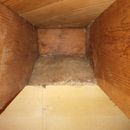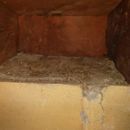Insulating the rim joists of an old house
cbernard8
| Posted in Energy Efficiency and Durability on
Hello everyone!
My name is Chase, this is my first post here on GBA. I’ve reading GBA for the past year or so.
A bit of context to my question: I’m in Climate Zone 6A (Minneapolis, MN). I am a homeowner and am finishing the basement of my 1949 rambler. I’m wanting to insulate my block foundation in my basement. This will probably be polyiso for the walls and closed cell foam for the rim joists.
The predicament I am running into is that my rim joists appear to sit directly on the block foundation walls with no mudsill and no capillary break.
To boot, my rim joists also are backfilled at the top with concrete/mortar of some kind (see photo in the gallery.). Though the rim joists seem to be fine
up to this point, I am concerned that insulating the interior of the rim joists will cause rot since I’m limiting the inward drying and making the floor/rim joists colder (wetter).
Some other relevant background information:
-Basement seems dry and I have yet to see any bulk water intrusion (although I’ve only lived in the house for 1.5 years)
-exterior grading is good
-I have rain gutters with downspouts directing water away from the house.
-2′ to 4′ overhangs surround the house. 4 foot on the south side and 2 foot on the north side.
-Most rim joists look healthy but a minority of them have some have water stains, no signs of rot or decay though.
-I’ve heard from neighbors and contractors in the area that my neighborhood has good soil (very sandy soil).
-I have no idea about footer drains at the foundation, but given that the house is from 1949, I highly doubt there are any.
-The house has survived with no sump pump or interior drainage system. The block basement walls are in pretty good shape with some minor bowing on one wall.
-The rim joists are about a foot to 6 inches above grade at various points around the house.
-The rim joists were insulated with some sort of old loose-fill fiberglass before I removed it (and has not rotten despite this)
I’ve read as much as I can on this topic, including Martin’s embedded rim joists article. My rim joists are not truly embedded since the exterior is not embedded in concrete, but they are resting directly on the foundation without a capillary break and are partially embedded in mortal on the interior (as I mentioned earlier).
Given the above information, am I safe to insulate my rim joists with closed cell foam? Or is that too risky and I should install a capillary break? I am
willing to install the capillary break, but it would be a tedious process as I would have to chisel out the back-filled mortar before jacking up the foundation to install the capillary break.
I am not considering insulating on the exterior as this would be out of my budget and is too beyond the scope of my basement remodel.
Any thoughts or suggestion would be much appreciated.
Thank you,
Chase
GBA Detail Library
A collection of one thousand construction details organized by climate and house part
Search and download construction details











Replies
It could be fine, it could slowly cause damage. There might not be enough data to show the true risk.
One thing that can help mitigate is embedding a borate preservative into the wood before covering it up. It will fight against rot. Example: https://www.systemthree.com/products/borate-rods
Another random thought I just had... depending on the time table and your willingness to conduct a science experiment, you could insulate a few bays (3, perhaps) with rigid foam to simulate closed cell, but have a moisture monitor embedded in the middle bay and see how it does over a year.